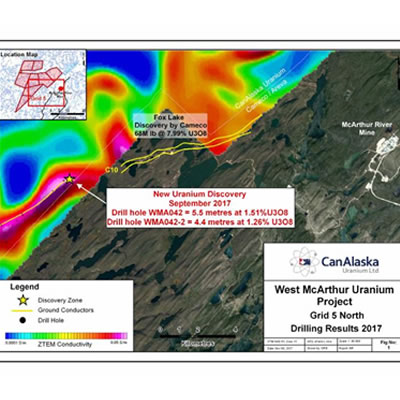Drill assay results confirm West McArthur uranium discovery

Graphic of the West McArthur Uranium Project. — Photo courtesy CanAlaska Uranium Vancouver, Canada. November 15, 2017 - CanAlaska Uranium Ltd. (TSX-
Graphic of the West McArthur Uranium Project. — Photo courtesy CanAlaska Uranium
Vancouver, Canada. November 15, 2017 - CanAlaska Uranium Ltd. (TSX-V: CVV; OTCQB: CVVUF; Frankfurt: DH7N), ("CanAlaska" or the "Company") is pleased to report final results from drill holes WMA042 and WMA042-2, on the West McArthur uranium project ("Project"). The drill program was conducted by Cameco Corporation (TSX: CCO; NYSE: CCJ) ("Cameco") as part of their $12.5 million option to earn a 60% interest in the Project.
Drill holes WMA042 and WMA042-2 were drilled at the northern end of a strong geophysical anomaly which represents the offset and continuation of the C10 conductor which hosts a new high-grade uranium deposit at nearby Fox Lake. The two drill holes intersected high-grade uranium within a broad fault controlled zone of strongly bleached sandstone accompanied by a pyrite halo just above the Athabasca sandstone unconformity.
In drill hole WMA042, strong pervasive brick-red hematite from 697.8 m to 700.2 m transitions into irregular patchy hematite with pervasive fracture-controlled sooty pyrite and localized perched fracture-controlled uranium mineralization to 715.6 metres. The remainder of the sandstone column is strongly bleached and overprinted by weak sooty pyrite as a halo about a brittle fault zone from 738.9 to 743.2 metres that is characterized by strong quartz dissolution (~25% core loss), sooty pyrite, and steeply dipping fractures. Below the fault, the sandstone is weakly silicified to 773.8 metres, below which pervasive sooty pyrite overprints the sandstone and is associated with orange-brown oxides, local fracture controlled brick-red hematite and disseminated uranium mineralization (Table 1). The unconformity was intersected at 782.1 metres.
In drill holes WMA042-2, bleached sandstone with weakly disseminated sooty pyrite leads to a brittle fault zone from 710.8 to 718.2 metres. The fault zone is characterized by broken core, steeply-dipping coated fractures and gouge, core loss as a result of structurally-controlled quartz dissolution, weak limonite and strong sooty pyrite. Below the fault zone, strong disseminated and fracture-controlled sooty pyrite and clay alteration continue to 721.3 metres, followed by competent bleached sandstone with pervasive weak sooty pyrite and local dravitic fractures to 768.4 metres. A brittle sandstone fault is characterized by broken to unconsolidated core with strong sooty pyrite, 16% core loss, strong quartz dissolution, and strong clay replacement that includes 10-40 cm wide sections of massive clay from 768.4 metres to the unconformity at 778.0 metres. Disseminated uranium mineralization is hosted within the fault zone, upgraded in the intervals of massive clay.
The geochemical uranium halo above the mineralization is extensive. It extends 100 metres above the unconformity and is then followed by a second, fault controlled, uranium and high boron halo from 170 metres to over 500 metres above the unconformity.
Drill holes WMA035 and WMA043-1, located 300 metres to the southeast, intersected the unconformity 30 metres lower, indicating a step-fault between the two sets of drill holes. These holes are marked by strong bleaching above and below the unconformity along faults with silicification reaching 300 metres above the unconformity. The uranium halo reaches 350 metres above the unconformity and is accompanied by a significant high boron halo (780+ metres) that comes close to surface.
Cameco is carrying out the current work as part of an option to earn a 60% interest in the West McArthur project. Cameco has paid CanAlaska an initial $725,000 and has the right to earn a first stage 30% interest for a $5 million exploration program within 3 years ($2.9 million to date) on two separate target areas: Grid 1 and Grid 5. Cameco will then have the right, after a $500,000 payment, to carry out a further $6.275 million of work on the Project over the following 3 years, to earn a further 30% interest and form a Joint Venture (JV) with CanAlaska.
The West McArthur uranium project covers 35,830 hectares (88,536 acres) commencing 15 kilometres (9 miles) west of Cameco's majority-owned McArthur River uranium mine. More importantly, the Project is immediately adjacent to Cameco's Fox Lake uranium discovery with reported inferred resources of approximately 68.1 million lbs based on 387,000 tonnes at 7.99% U3O8. The Fox lake discovery is within the Read Lake project operated by Cameco (Cameco 78.2%, Areva 21.8%). Further information on Project is available at http://www.canalaska.com/s/West_McArthur.asp?ReportID=560713.
CanAlaska president Peter Dasler comments, "CanAlaska management is very impressed with the size of the target and the high-grade uranium intercepted at the C10 conductor. The strong alteration halos, which reach 400-700 metres above the unconformity, show that there has been extensive fluid flow in the system. We also now know that there is a significant fault located in the region between the C10 and C10 south conductor targets, and believe more mineralization will be found in this structure. We look forward to Cameco's next drill program for this target."
About CanAlaska Uranium
CanAlaska Uranium Ltd. (TSX-V: CVV; OTCQB: CVVUF; Frankfurt: DH7N) holds interests in approximately 152,000 hectares (375,000 acres), in Canada's Athabasca Basin - the "Saudi Arabia of Uranium." CanAlaska's strategic holdings have attracted major international mining companies. CanAlaska is currently working with Cameco and Denison at two of the Company's properties in the Eastern Athabasca Basin. CanAlaska is a project generator positioned for discovery success in the world's richest uranium district. The Company also holds properties prospective for nickel, copper, gold and diamonds. For further information visit www.canalaska.com.
About Cameco Corporation
Further information on Cameco can be found at www.cameco.com.




